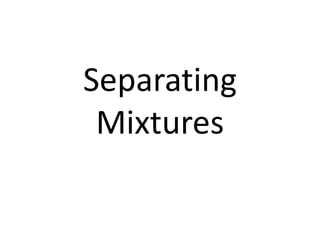Grade 6 Separating Mixtures
•Download as PPT, PDF•
0 likes•568 views
Separating Mixtures Grade 6 Lesson
Report
Share
Report
Share

Recommended
Recommended
More Related Content
What's hot
What's hot (20)
Presentation of mixtures & solutions.pptx by kk shai

Presentation of mixtures & solutions.pptx by kk shai
Iccs science6 solutionssuspensionsandcolloids 110212065006-phpapp01

Iccs science6 solutionssuspensionsandcolloids 110212065006-phpapp01
Similar to Grade 6 Separating Mixtures
Similar to Grade 6 Separating Mixtures (20)
Ch.10.less.2.how are mixtures formed and separated

Ch.10.less.2.how are mixtures formed and separated
Ch.10.less.2.how are mixtures formed and separated

Ch.10.less.2.how are mixtures formed and separated
Iccs science6 separatingmixtures 130701082145-phpapp01

Iccs science6 separatingmixtures 130701082145-phpapp01
Separation techniques and enterance to chromatography

Separation techniques and enterance to chromatography
Recently uploaded
Recently uploaded (20)
Introduction to TechSoup’s Digital Marketing Services and Use Cases

Introduction to TechSoup’s Digital Marketing Services and Use Cases
HMCS Vancouver Pre-Deployment Brief - May 2024 (Web Version).pptx

HMCS Vancouver Pre-Deployment Brief - May 2024 (Web Version).pptx
On National Teacher Day, meet the 2024-25 Kenan Fellows

On National Teacher Day, meet the 2024-25 Kenan Fellows
Sensory_Experience_and_Emotional_Resonance_in_Gabriel_Okaras_The_Piano_and_Th...

Sensory_Experience_and_Emotional_Resonance_in_Gabriel_Okaras_The_Piano_and_Th...
Beyond_Borders_Understanding_Anime_and_Manga_Fandom_A_Comprehensive_Audience_...

Beyond_Borders_Understanding_Anime_and_Manga_Fandom_A_Comprehensive_Audience_...
PANDITA RAMABAI- Indian political thought GENDER.pptx

PANDITA RAMABAI- Indian political thought GENDER.pptx
Simple, Complex, and Compound Sentences Exercises.pdf

Simple, Complex, and Compound Sentences Exercises.pdf
Interdisciplinary_Insights_Data_Collection_Methods.pptx

Interdisciplinary_Insights_Data_Collection_Methods.pptx
Grade 6 Separating Mixtures
- 2. What is a mixture? • When two or more materials or substances are mixed together but do not chemically combine. • This means they retain their original properties. • This means they can be separated by physical means.
- 3. What are the different ways of separating mixtures? • Magnetism • Hand separation • Filtration • Sifting or sieving • Extraction and evaporation • Chromatography
- 4. Magnetism • If one component of the mixture has magnetic properties, you could use a magnet to separate the mixture. Iron, nickel, and cobalt are all materials that are magnetic. • Not all metals are magnetic: gold, silver, and aluminum are examples of metals that are not magnetic.
- 5. Example of magnetism • Using a magnet to separate nails from wood chips.
- 6. Hand separation • Separating the parts of a mixture by hand. • Only useful when the particles are large enough to be seen clearly. • Useful for: separating parts of a salad.
- 7. Example of hand separation: • Using your fork to separate tomatoes, lettuce, cucumber, onions, etc. in your salad.
- 8. Filtration • Used when separating a solid substance from a fluid (a liquid or a gas) by passing a mixture through a porous material such as a type of filter. • Works by letting the fluid pass through but not the solid. • Examples of filters: coffee filter, cloth, oil filter, even sand!
- 9. Example of filtration: • Using a coffee filter to separate the coffee flavor from the coffee beans.
- 10. Sifting or sieving • Used to separate a dry mixture which contains substances of different sizes by passing it through a sieve, a device containing tiny holes.
- 11. Example of sifting/sieving: • Using a sieve to separate sand from pebbles.
- 12. Extraction • Used to separate an insoluble solid (something that doesn’t dissolve in a liquid) from a soluble solid (something that DOES dissolve in a liquid). Done by adding a solvent (liquid that does the dissolving) to the mixture. Then pouring the liquid through a filter.
- 13. Example of extraction • With a mixture of sugar and sand, pouring water in the mixture which causes the sugar to dissolve. Then pouring the solution through a filter, causing the sand to separate from the sugar water.
- 14. Evaporation • Allowing the liquid to evaporate, leaving the soluble solid behind. • Example: heating sugar water. The water evaporates and the sugar crystals are left behind.
- 15. Example of using extraction and evaporation together: • Using water to dissolve sugar, then letting the water evaporate, leaving the sugar behind.
- 16. Chromatography • Used to separate dissolved substances in a solution from each other. Mixture Components Separation Stationary Phase Mobile Phase
- 17. Example of chromatography: • Using chromatography paper to separate ink into it’s original components.